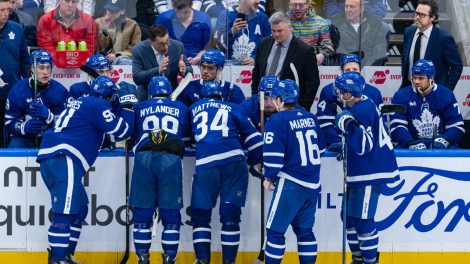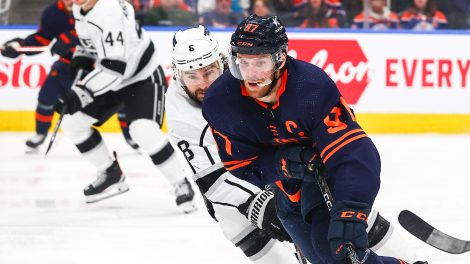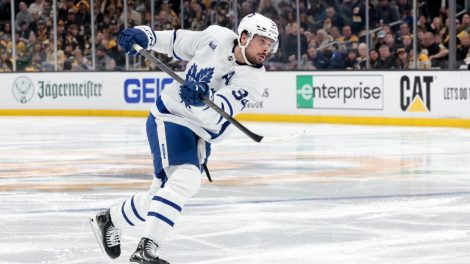If you ask Gary Bettman or anyone else from the NHL office, they’ll be more than happy to tell you all about how great the competitive balance is across the league.
They’ve been toeing that company line for years now, parroting the same points about a) how the randomness and unpredictably we see in the standings from year to year is a good thing, b) how that shows the NHL has unrivalled parity, and as a result c) how the point structure in place is here to stay.
Whether those first two points are actually even a net positive for the league is ultimately a question of personal preference, but the argument in favour of the point system that rewards teams evenly regardless of when they win is one that’s becoming exceedingly untenable.
The aptly named loser point is only really a red herring that muddies the waters and tricks people into thinking their teams are in a better position than they really are.
[snippet id=3317857]
As a result, aside from the few teams at both ends of the extreme that are either exceptionally dominant or shockingly poor, the standings are essentially one big jumbled mess. There are 17 teams somewhere between 46 and 53 points. In the Metropolitan Division, three measly points separate fourth place (which is ostensibly the first wild card) and eighth place.
The same thing is also true in the Central Division, which means that in the Western Conference it looks like there will be six teams fighting tooth and nail for just two playoff spots.
That type of mayhem has a certain appeal and increases the importance of every matchup between any of those teams, while keeping a larger chunk of the sport’s fanbase hooked.
But it doesn’t teach us much, so it’s up to us to figure out what’s really going on now that we’re past the halfway point and counting down to the trade deadline. This is the part of the season where taking a step back and being able to critically evaluate where you’re at as a team can pay dividends with so few clearly defined buyers and sellers in the market.
With that in mind, let’s cut through the fat and dig a little bit deeper in an attempt to figure out who’s actually good, and who’s hanging on by a thread. We’ll do so by taking a closer look at underlying performance indicators that may help us project ahead more accurately than the usual rudimentary analysis of wins and losses.
Thanks to the help of Natural Stat Trick (for the data) and to Micah Blake McCurdy (for turning those numbers into a beautiful visual) here’s a look at how often teams have been leading versus trailing this season. As a frame of reference, the goal is to be in the top right segment of the chart, although that was probably made obvious as soon as the letters ‘B-U-F’ flashed on the bottom left of it.

A few quick-hitters:
I don’t think anyone is surprised to see the Lightning, Jets, and Predators near the top of the list. The Lightning have separated themselves from the rest of the pack out East and are the undisputed class of the conference. The Jets and Predators are right there atop the West, though the case for either of them as the leader of the pack is far less clear cut. The Blues and Kings most notably might have something to say about that.
You may have noticed the Golden Knights just below them, and I’m slowly but surely warming up to the idea that they’re there to stay. Since a slow, percentage-fueled start to the year they’ve been steadily improving to the point where their past 25 or so games have been legitimately dominant.
At worst, Vegas is going to continue being devastating to play against at home, and frustrating to play against anywhere. They operate at a frantic pace teams struggle to adjust to, and they’re deep enough to chip away and eventually take advantage of any liabilities opponents have at the bottom of their lineup. It’s fair to be skeptical how it’ll translate to the post-season where star power reigns supreme, but that shouldn’t preclude you from enjoying this run while it lasts.
The teams I’m most intrigued by on here are the Stars and Bruins. When talking about the best teams in the league they tend to lag behind those other top teams, but there’s some awfully encouraging data to suggest they’re both terrifyingly dominant in similar ways at five-on-five. They’re first and second in expected goals, and sandwich the Lightning atop the shot share leaderboard.
For the Bruins, the decision to keep the top line intact and figure everything else out after that is as cut and dry as it gets. Especially if they’re going to continue to get anything resembling consistent secondary scoring from young players like Danton Heinen and Jake DeBrusk, as they have during this torrid stretch; in their past 10 games the Bruins have won eight times, lost twice after regulation, and outscored opponents 44-16.
For the Stars, the decision isn’t as simple. Ken Hitchcock has experimented with splitting up his Big 3 forwards, opting for a more balanced look. While it makes sense for now, having the option to go power versus power by putting Benn, Seguin, and Radulov together is an endlessly tantalizing one. Especially when you see the manner in which they eviscerated the Oilers this past weekend. They may not be as fun to watch as they once were, but it’s impossible to argue with the results. The Stars are as good as they’ve ever been.
[snippet id=3816507]
I’d like to see what the Ducks can do now that they’re finally icing a competitive lineup. Their underlying numbers are dreadful thus far, but you almost have to toss them out the window because of their unique circumstance. As key contributors have fallen like flies they’ve needed to piece the lineup together: As far as most even strength minutes played among the forwards on their team this season, Antoine Vermette is third, Chris Wagner is fifth, Derek Grant is eighth, and Logan Shaw is ninth.
If anything, it’s impressive Anaheim has stayed afloat, and it’s a testament to the life raft that their goaltending has provided. If they bounce back to their form from last year (closer to the middle of the pack, if not top 12-15 at five-on-five), they’re remarkably still in a position to make some noise in the second half.
The Islanders season is on life support. They’re right there in that stack of Metro teams, but unless they do something to stop the bleeding and tend to their needs they won’t be for long. They’ve been getting pummelled of late, and their inability to keep the puck out of their own net is seriously troublesome. But they do have two great scoring lines, and a unique window where their top two centres and wingers are making just $13 million combined. Garth Snow and the Islanders have been unflinchingly patient to a fault over the years, but considering the magnitude of John Tavares’ decision this summer, it’d be dangerously negligent for them to not do everything in their power to finish strong this season.
We’ve been putting it off for as long as we could because it’s a complicated subject with extenuating circumstances, but let’s have the conversation about the Pittsburgh Penguins.
Part of the reason their struggles haven’t gotten the attention they deserve is because there’s been a number of other playoff teams that came into this season with similar expectations – like the Senators, Oilers, and Canadiens – that have crashed and burned far more spectacularly.
More importantly, by now the Penguins have earned the benefit of the doubt for how they’ve won the past two Stanley Cups. In 2015-16, they similarly sluggishly sleepwalked their way through the first couple months of the season before making a coaching change and flipping the switch. Last year, in the process of winning it all they overcome a) a relatively pedestrian underlying resume, and b) a ragtag group of defencemen who would make some AHL teams blush.
The fact that we’ve seen the Pens do it already understandably makes it easier to envision a scenario in which they somehow do it again, but at the same time that’d be like expecting someone who’s won the lottery in the past to do it again. This is a different team, and a different year, and we need to evaluate it for what it is.
So what are the Penguins exactly?
There’s certainly some alarming red flags there. They’ve only held a lead for less than a quarter of their games, and only the Sabres, Coyotes, and Oilers have been ahead a smaller percentage of the time. Only those three teams (plus the Islanders and Panthers) have been playing from behind more often than the Penguins.
At five-on-five, they’ve been outscored by a whopping 37 goals for the year and only the Arizona Coyotes are worse. Meanwhile, no team has given up more 5-on-5 goals against than Pittsburgh’s 100 (those same Coyotes are tied with them there, and I’m sensing a recurring theme here).
| Team | 5v5 Goal Differential | PP Goal Differential | PK Goal Differential | Overall Goal Differential |
|---|---|---|---|---|
| TBL | +37 | +36 | -23 | +50 |
| BOS | +27 | +22 | -17 | +32 |
| WPG | +12 | +39 | -25 | +26 |
| VGK | +15 | +23 | -19 | +19 |
| LAK | +15 | +19 | -16 | +18 |
| NSH | +8 | +33 | -26 | +15 |
| COL | +4 | +30 | -19 | +15 |
| CHI | +11 | +23 | -22 | +12 |
| TOR | +9 | +24 | -21 | +12 |
| STL | +15 | +19 | -23 | +11 |
| DAL | +13 | +22 | -26 | +9 |
| NJD | +2 | +24 | -18 | +8 |
| ANA | +9 | +19 | -21 | +7 |
| NYR | +4 | +23 | -22 | +5 |
| SJS | -12 | +31 | -15 | +4 |
| PHI | +10 | +23 | -30 | +3 |
| WSH | +11 | +20 | -28 | +3 |
| CGY | +5 | +19 | -26 | -2 |
| MIN | -4 | +21 | -21 | -4 |
| CBJ | +5 | +12 | -23 | -6 |
| CAR | -6 | +18 | -21 | -9 |
| DET | -14 | +19 | -16 | -11 |
| NYI | -2 | +21 | -30 | -11 |
| FLA | -12 | +18 | -19 | -13 |
| MTL | -11 | +22 | -24 | -13 |
| PIT | -37 | +40 | -22 | -19 |
| VAN | -17 | +24 | -29 | -22 |
| EDM | -9 | +16 | -33 | -26 |
| OTT | -18 | +18 | -27 | -27 |
| BUF | -27 | +8 | -23 | -42 |
| ARI | -43 | +18 | -19 | -44 |
And yet as concerning as all of that should be on paper, no one wants to be the sucker that bets against Sidney Crosby and Evgeni Malkin (and Phil Kessel, who needs to be mentioned because he’s having a prolific offensive campaign).
As many holes as there transparently are in their lineup, that kind of firepower gives you pause before writing them off. Their top gear is special, and it’s remarkable how it can bring along the passengers for a ride on the good days.
We’ve seen that in full effect on the power play, where the Penguins are chugging along at a historically great rate this season. They’re currently scoring north of 10 goals per hour when up a man, which only the 2008-09 and 2012-13 versions of the Washington Capitals have managed to exceed since 2006.
The other encouraging thing working in their favour is PDO. The stat can be a rollercoaster, and after experiencing the highs of it during the Cup run last year, the Penguins are now feeling the nauseating side effects of its lows. They’re 31st in both save percentage and shooting percentage at five-on-five, which is a big reason for that shockingly poor aforementioned goal differential.
Their current PDO (combining shooting and save percentage) of 95.43 would be the lowest recorded total in the analytics era, only rivalled by the 2012-13 Florida Panthers and.. this year’s Arizona Coyotes (!). Pittsburgh’s 50.7 per cent expected goal rate is middle of the pack and hardly anything to boast about, but would also represent a vast improvement over their current actual rate of 38.2 per cent.
It will be fascinating to monitor the next six weeks leading up to the trade deadline in Pittsburgh.
They’ve been heavily involved in trade rumours, and figure to be a team that’ll look different after the deadline than it does now as they try and squeeze everything out of its current core of players.
None of it may ultimately matter if they don’t start getting more favourable bounces, because if the old adage in the NBA is that good offence beats good defence then the NHL’s equivalent is that bad PDO beats both.
For now Pittsburgh is still in the thick of the hotly contested playoff race, which is both surprising in the positive sense (based on everything that’s gone wrong) and negative sense (based on the expectations we all had for them heading into the year).
[relatedlinks]








